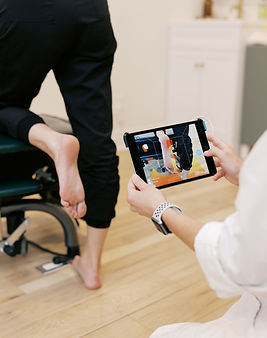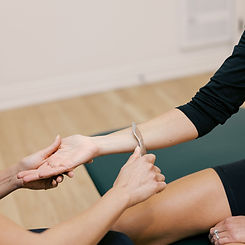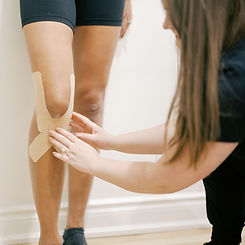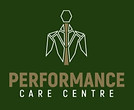
CHIROPRACTIC
Our chiropractors practice a diversified technique in order to treat all aspects of the musculoskeletal system. This includes all muscle, joint, and nerve related issues. Joint manipulation is a commonly used technique within the chiropractic scope of practice, and entails the passive movement of a skeletal joint using a high-velocity-low-amplitude thrust (HVLA). This is used in order to reduce pressure within the joint cavity, increase range of motion, and restore overall function.
Our chiropractors also use various soft tissue therapies and modalities in addition to this technique which can be found below.

MASSAGE THERAPY
Our massage therapists provide assessment and treatment of the soft tissues of the body, including the muscles, connective tissues, and joints. Treatment provides a therapeutic effect by working with the body's own healing factors, acting on the muscular, nervous and circulatory systems. This technique aims to develop, maintain and improve physical function by addressing physical dysfunction, pain and injuries.
Our massage therapists utilize deep tissue massage along with other modalities which can be found below to improve the and maintain patient health.
PHYSIOTHERAPY
Physiotherapy includes the assessment and treatment of injuries or pain that are related to the musculoskeletal system. This includes the bones, ligaments, muscles, joints and nerves. Physiotherapy aids in promoting optimal mobility, strength, and function for overall health and improved quality of life. Rehabilitation post-injury may include some of the following techniques; manual therapy, exercise prescription, acupuncture, pacing/planning, sport specific training and injury prevention.


PELVIC HEALTH PHYSIOTHERAPY
Pelvic health physiotherapy is a specialized technique designed to assess and treat the tissues, nerves and muscles of the pelvic region. Dysfunction of the pelvic floor can lead to urinary or fecal incontinence, urgency, overactive bladder, pelvic pain, pelvic organ prolapse, painful intercourse, painful menstruation, low back pain or hip pain.
Pelvic health physiotherapy can also help during pregnancy in the following ways.
-
Reduce urinary/fecal symptoms
-
Alleviate pelvic girdle, low back and hip pain
-
Prepare vaginal tissues for delivery
-
Provide safe exercises
Note: postpartum follow-up is recommended 6-8 weeks following delivery
PEDIATRIC CHIROPRACTIC
Chiropractic care focused in pediatrics assesses and treats dysfunction of the spine that may cause a child discomfort. The most common conditions treated include colic/irritability, developmental or motor delays, digestion issues, difficulties with feeding or latching, lip/tongue-tie, torticolis, and plagiocephaly. Care can also be provided to those who have experienced trauma or show signs of imbalance (head tilting, excessive crying, poor sleep, excessive spitting up, constipation or favouring a side).
Pediatric chiropractic adjustments are very gentle and safe. No audible sound or twisting of the spine is required in infant therapy. Instead, gentle pressure is used to facilitate proper movement and eliminate any restrictions of the spine. Manual techniques are modified to age, size and developmental stage. Home exercise may often be prescribed in addition to support function.
It is recommended that the first visit take place within the first month of life. Follow-up visits are recommended during major milestones- starting to roll, sit, walk or crawl- and are assessed at 3 months, 6 months, 9 months, 12 months, and 18 months.

PEDORTHICS
This assessment involves a thorough evaluation of the entire lower extremity, from the hips to the feet. It aims to identify any structural or functional issues, injuries, or abnormalities in the lower limbin order to provide optimal treatment. Appointments structure is outlined below:
1. Patient History: The healthcare professional will take a detailed medical history, including information about the patient's current symptoms, medical conditions, past injuries, and any relevant family history.
2. Posture Observations: Gait and patient posture is observed in various positions to outline any asymmetry, abnormality or imbalance.
3. Physical Exam: Analysis of the feet, ankles, knees, hips, and lower back is completed assessing alignment, range of motion, muscle strength, and join stability. Muscular strength in the lower limb is assessed through manual resistance or specialized testing motions. Any imbalance or weakness is noted.
4. Neurologic Assessment: Any signs or nerve compression, dysfunction or neuropathy through sensory perception and muscle strength testing is noted.
5. Gait Analysis: Walking or running patterns are analyzed to observe how the feet and lower limbs move during various stages of the gait cycle. This helps identify abnormalities throughout the cycle that may be impacting or contributing to the primary complaints of the patient.
6. Biomechanical Analysis: Various techniques are used to analyze the patient's biomechanics, such as assessing joint stability, muscle imbalances, and the alignment of the feet, ankles, knees, hips, and spine.
7. Footwear Analysis: Footwear is analyzed for wear patterns which indicate specific areas of stress on the feet that may relate to biomechanical changes.
8. Treatment Plan: A personalized treatment plan that may include exercise programs, manual therapy, bracing, orthotics and other interventions is developed based on the assessment findings.
If you believe you are a candidate for medical bracing or compression socks, book now.


ACUPUNCTURE
MEDICAL ACUPUNCTURE
Fine, solid needles are inserted into anatomically defined neurofunctional sites along the meridians of the body. They can then be stimulated with electrical current for the therapeutic purpose of modulating abnormal activity within the nervous system.
FUNCTIONAL INTEGRATED NEEDLING
This technique differs from medical acupuncture, as meridians are not used. Instead, needles are inserted into specific anatomical structures to promote blood flow, and decrease muscle tension and pain.
Our chiropractors offer both techniques and include them based on patient presentation.

CONCUSSION MANAGEMENT
PCC is proud to be a certified Complete Concussions location. Full evidence-based concussion management programming is available including pre-season baseline testing to concussion treatment/rehabilitation. Our goal is to help our patients and athletes safely return to learning, working and playing.
Strategies and services include:
-
Balance rehab
-
Nutritional interventions
-
Vision rehab
-
Cognitive testing
-
Integrated manual therapy
-
Exercise rehab
-
Educational resources

ADDITIONAL MODALITIES
RED LIGHT/NEAR INFRARED LIGHT THERAPY
At PCC, we use the Biomax 900 by PlatinumLED due to its maximum power and full spectrum therapy capabilities. Several therapeutic wavelengths which penetrate different depths and support different healing processes can be utilized.
630-660nm (Red Light)
-
Target the surface: skin health, acne, collagen production, wound healing
810-850nm (Near-Infrared)
-
Deeper target: Supports muscle recovery, joint pain relief, and nerve regeneration
940-1060nm (Far-Infrared)
-
Deepest target: Used for brain health, cognitive support and systemic inflammation
CUPPING
Cupping is an ancient therapeutic technique which creates suction on the skin to promote blood flow and reduce muscle tension
INSTRUMENT-ASSISTED SOFT TISSUE MOBILIZATION
A stainless steel instrument is used to scan the body for fascial restrictions, adhesions, and scar tissue. Controlled micro-trauma is produced in order to stimulate specialized nerve endings in the fascia and skin. As a result fascial tone is normalized.
PERFORMANCE TAPING
The application of tape is utilized in order to restrict the activity of tight musculature and facilitate activity of under-utilized muscle. Performance taping may also be used to aid in postural deviations and to optimize athletic performance.
COMPRESSION SOCKS
Compression socks/stockings are designed to apply gentle pressure to the legs and ankles in order to promote blood flow back to the heart. They can also reduce pain and inflammation in the lower limb. Benefits include:
-
Venous support/prevention of blood pooling
-
Reduce inflammation
-
Reduce orthostatic hypotension
-
Aid in preventing venous ulcers and deep vein thrombosis
-
Reduce pain caused by varicose veins
-
Promote lymphatic drainage




CORRECTIVE EXERCISES
Corrective exercises are utilized in order to correct postural imbalances, address muscular asymmetry, and to recover following injury or surgery.
PRE-REHABILITATION/POST-REHABILITATION
By strengthening atrophied musculature pre- and post- surgery, recovery can be optimized and the effects of compensation can be minimized.
Check our Rehab Video section for more information.



